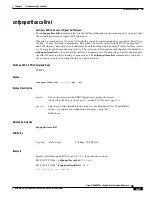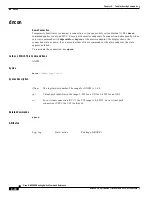
9-38
Cisco MGX 8850 Routing Switch Command Reference
Release 2.0, Part Number 78-10467-04 Rev C0, October 2001
Chapter 9
Troubleshooting Commands
cnfxbarerrthresh
cnfxbarerrthresh
Configure Crossbar Error Threshold—specify a threshold for a particular crossbar error
The Syntax Description contains a list of possible errors. A crossbar error threshold consists of:
•
A period for counting errors
•
Severity of the resulting alarm (minor, major, and critical)
•
Upper and lower counts for each alarm severity
Note
The default settings for crossbar error thresholds are optimal for nearly all applications. The
dspxbarerrthresh command shows the existing thresholds. If necessary, you can change thresholds
through the cnfxbarerrthresh command.
Cards on Which This Command Runs
PXM45
Syntax
cnfxbarerrthresh <errtype(1..9)> <threshtime> <severity(0..2)> <clrcount> <almcount>
Syntax Description
errtype
A number that identifies the type of error, as follows:
1.
Loss of synchronization (LossOfSync).
2.
Transceiver error (TranscieverErr)
3.
DisparityErr—an accumulation of five ASIC-level errors
4.
ParityErr—a parity error in the switch frame as a whole
5.
HeaderCRCErr—a CRC error for the switch frame header
6.
PayloadCRCErr—a CRC error for the switch frame payload
7.
RemapTwiceErr
8.
RemapRecurrErr
9.
Backpressure parity error (B.P.ParityErr)—a parity error in the signaling for
backpressure
threshtime
The number of milliseconds over which the system counts errors.
severity
The severity of the alarm resulting from the error count per threshold time.
clrcnt
The clear count is the number of errors below which the alarm changes to the next
lowest severity. For example, the system clears a minor alarm for a particular type of
error when the number of errors goes to 0. Similarly, if clrcnt for a major alarm is 30,
the alarm goes to minor when the count drops below 30.
















































